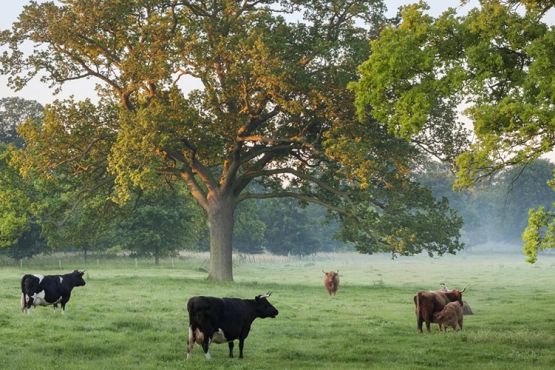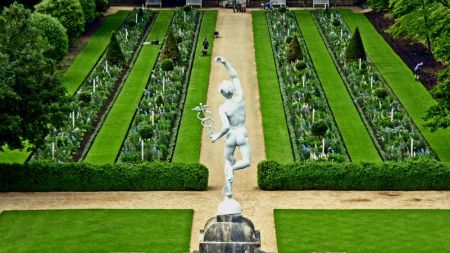Green Recovery at Wimpole

As part of the Green Recovery Challenge Fund, Wimpole has received £1.3m from Defra to develop its cultural landscape, and deliver a wide range of benefits for nature, carbon and people. The Green Recovery Fund will help to create and restore habitats, support solutions to tackle climate change and connect people with nature.
Work is now underway on the National Trust’s largest and most diverse tree planting project which will help us to achieve our ambition to become net carbon zero by 2030.
The Historic Landscapes programme has been awarded £3.85m by Defra as part of the Green Recovery Challenge Fund. The funding will kickstart a programme of work, worth over £4.7 million, to enhance nature and start to combat the effects of climate change in five of the most significant historic landscapes in the care of the National Trust, including Wimpole Estate.
Through the Historic Landscapes programme, Wimpole has received £1.3m in funding. As part of the green recovery project, the work will focus on three areas: nature conservation and restoration, tackling climate change and connecting people with nature.
90,000 trees are being planted across the wider Wimpole estate, away from the Grade I registered parkland, including 120 hectares (296 acres) of woodland, wood pasture and agroforestry, by the middle of March.
As with other landowners across the country, one of the biggest challenges facing the estate is climate change and how to manage the land to help mitigate its effects, while increasing benefits for nature and still running a profitable and productive business.To tackle the issue the team is now planting 32 hectares (79 acres) of new woodland, 49 hectares (121 acres) of wood pasture and 39 hectares (96 acres) of agroforestry.
39 different native apple tree varieties will be planted including many heritage species creating a belt of agroforestry – with six types grown for harvesting and juicing to include Ashmead’s Kernel, Egremont Russet and Greensleeves.
The team aims to generate income from growing apples, while still being able to harvest cereal crops, as it has done for the past 12 years.
David Hassall, Farm Manager at Wimpole said:
“The 2,000 apple trees will be planted in rows to link two areas of well-established woodland, roughly 330 meters apart, to help encourage the estate’s rare barbastelle bat population to travel between the woods, with cereal crops growing in between.
“The apple trees will provide food for pollinators, particularly bees, when blossom emerges in the spring and the wildflower rich strips which the trees are planted in will support a range of wildlife.
“The wood pasture and areas of new woodland will help counter drought, as once established the trees will help hold water in the landscape, as well as attracting plenty of worms and fungi which will help soil health and store carbon.
“This means that we can continue to plant our arable crops and have healthy grazing pasture for our rare breed cattle and sheep.”
Due to Wimpole’s ancient landscape – which has been occupied by people for at least 5,000 years – one of the first jobs undertaken was a comprehensive study of the areas of the estate being considered for tree planting. This study concentrated on areas of less productive arable land and where they would give the greatest benefit to nature.
The charity commissioned a geophysical survey of all the woodland planting areas to locate any archaeological remains. This survey made some significant discoveries which resulted in alterations to the planting plans to preserve these sites.
The team also worked closely with, and took advice from many partners, including the Woodland Trust, Natural England, RSPB, Historic England and Forestry England.
Project Manager Jason Sellars said:
“Ten months in the planning and with three intensive months of tree planting underway, we want to demonstrate how action to tackle climate change and to aid nature’s recovery can be undertaken in a relatively short space of time.
“Once all the trees are planted, we’ll enter a 3-5 year period where we’ll leave the trees to establish and grow before introducing livestock.”
Archaeologist Angus Wainwright who led the historic studies of the estate said:
“Wimpole has always been a place of dynamic change. Many might think that Wimpole seems a bit of timeless English countryside but really it has never stood still. Through the research we’ve conducted we’ve uncovered the waxing and waning of tree planting which has been going on at Wimpole for centuries, and we are continuing that trend.”
To ensure the team has a clear picture of how the tree planting might affect biodiversity and wildlife numbers in the future, a baseline ecology survey has been carried out.
12 volunteers have been trained over the past ten months to ensure accurate and regular ongoing records can be maintained.
National Trust Ecologist, Alison Collins said:
“We’ve been able to reset the biodiversity baseline for Wimpole by surveying for bats, butterflies, birds and plants. We’ve worked with volunteers to show them how to take transect records of species and we now plan to survey the same areas going forwards.
“As the trees start to grow and the new habitats become established, we obviously hope to see the numbers increase, but also that other wildlife moves in, such as additional bat and butterfly species attracted to the new areas of woodland and other habitats.”
Categories
- Apprenticeships (52)
- Building Surveying (3)
- Business Services (1)
- Catering (1)
- Communications and Marketing (3)
- Conservation (9)
- Countryside (10)
- Curatorship (3)
- Diversity (1)
- Estate Management (4)
- Finance (2)
- Food and Beverage (6)
- Fundraising (8)
- Gardening (11)
- General Management (2)
- Governance (2)
- Heritage Building Crafts (4)
- Holidays (3)
- House and Collections (4)
- IT (8)
- Membership (1)
- People and Legal (3)
- Projects and Programmes (6)
- Retail (2)
- This is us (5)
- Visitor Experience (3)
- Volunteer and Community (3)
- Volunteering (1)
- Work Experience (1)
- Young People (12)

